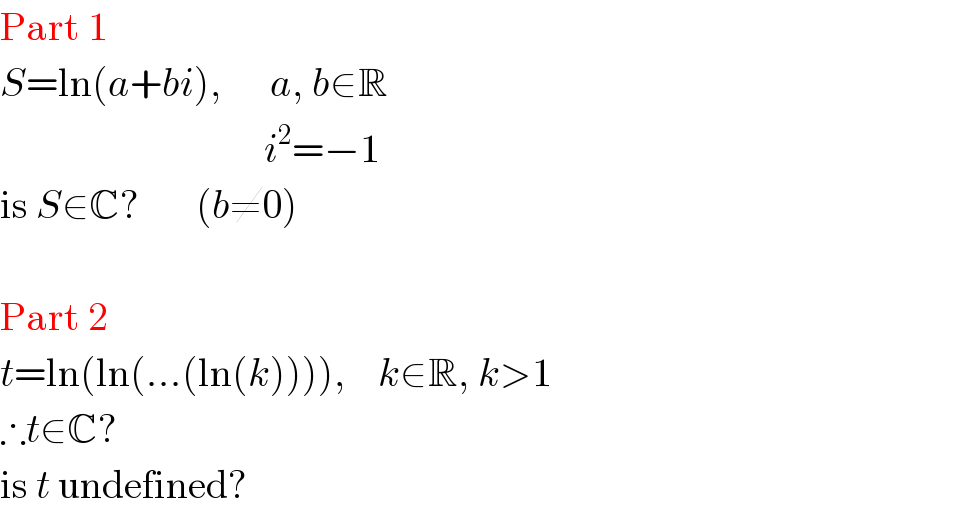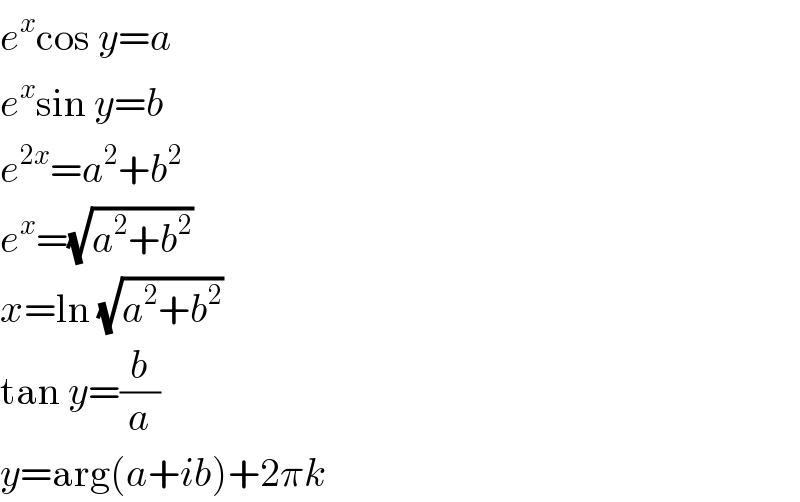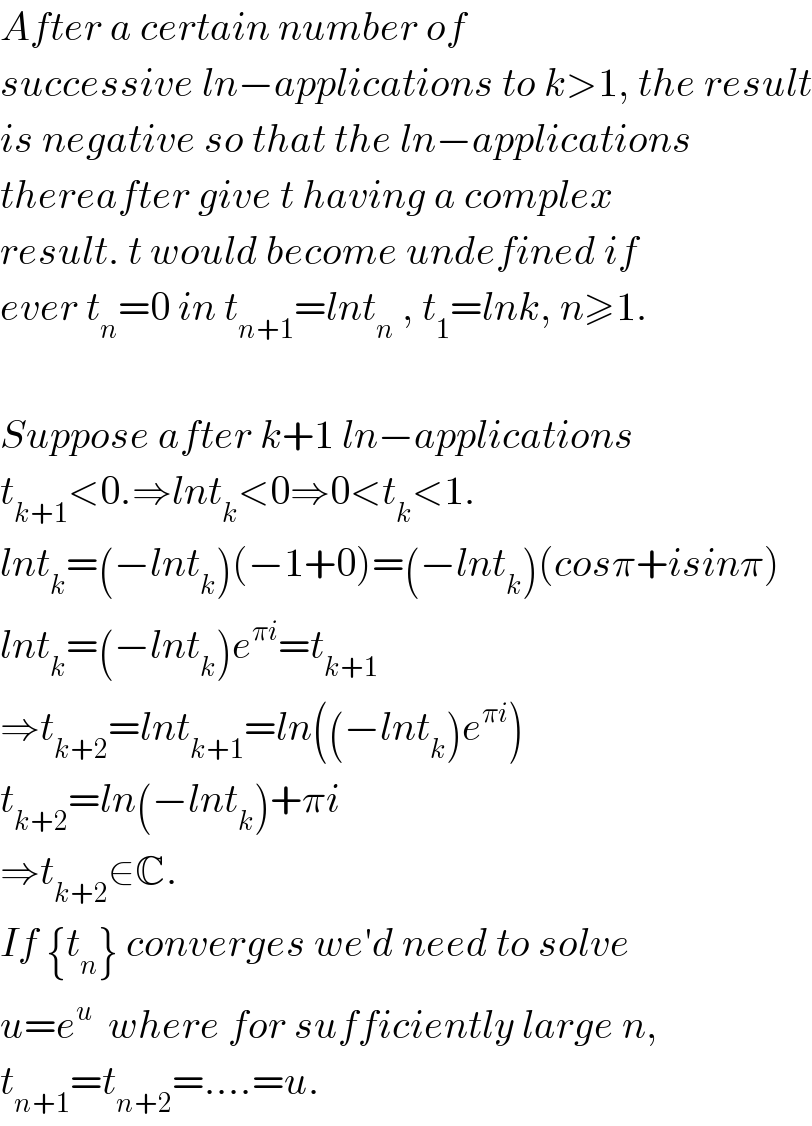Question Number 5091 by FilupSmith last updated on 11/Apr/16

$$\mathrm{Part}\:\mathrm{1} \\ $$$${S}=\mathrm{ln}\left({a}+{bi}\right),\:\:\:\:\:\:{a},\:{b}\in\mathbb{R} \\ $$$$\:\:\:\:\:\:\:\:\:\:\:\:\:\:\:\:\:\:\:\:\:\:\:\:\:\:\:\:\:\:\:\:\:{i}^{\mathrm{2}} =−\mathrm{1} \\ $$$$\mathrm{is}\:{S}\in\mathbb{C}?\:\:\:\:\:\:\:\left({b}\neq\mathrm{0}\right) \\ $$$$ \\ $$$$\mathrm{Part}\:\mathrm{2} \\ $$$${t}=\mathrm{ln}\left(\mathrm{ln}\left(…\left(\mathrm{ln}\left({k}\right)\right)\right)\right),\:\:\:\:{k}\in\mathbb{R},\:{k}>\mathrm{1} \\ $$$$\therefore{t}\in\mathbb{C}? \\ $$$$\mathrm{is}\:{t}\:\mathrm{undefined}? \\ $$
Commented by prakash jain last updated on 11/Apr/16

$${S}={x}+{iy} \\ $$$${e}^{{x}+{iy}} ={a}+{bi} \\ $$$${e}^{{x}} \left(\mathrm{cos}\:{y}+{i}\mathrm{sin}\:{y}\right)={a}+{bi} \\ $$
Commented by 123456 last updated on 11/Apr/16

$${e}^{{x}} \mathrm{cos}\:{y}={a} \\ $$$${e}^{{x}} \mathrm{sin}\:{y}={b} \\ $$$${e}^{\mathrm{2}{x}} ={a}^{\mathrm{2}} +{b}^{\mathrm{2}} \\ $$$${e}^{{x}} =\sqrt{{a}^{\mathrm{2}} +{b}^{\mathrm{2}} } \\ $$$${x}=\mathrm{ln}\:\sqrt{{a}^{\mathrm{2}} +{b}^{\mathrm{2}} } \\ $$$$\mathrm{tan}\:{y}=\frac{{b}}{{a}} \\ $$$${y}=\mathrm{arg}\left({a}+{ib}\right)+\mathrm{2}\pi{k} \\ $$
Commented by Yozzii last updated on 12/Apr/16

$${After}\:{a}\:{certain}\:{number}\:{of} \\ $$$${successive}\:{ln}−{applications}\:{to}\:{k}>\mathrm{1},\:{the}\:{result} \\ $$$${is}\:{negative}\:{so}\:{that}\:{the}\:{ln}−{applications} \\ $$$${thereafter}\:{give}\:{t}\:{having}\:{a}\:{complex} \\ $$$${result}.\:{t}\:{would}\:{become}\:{undefined}\:{if} \\ $$$${ever}\:{t}_{{n}} =\mathrm{0}\:{in}\:{t}_{{n}+\mathrm{1}} ={lnt}_{{n}} \:,\:{t}_{\mathrm{1}} ={lnk},\:{n}\geqslant\mathrm{1}. \\ $$$$ \\ $$$${Suppose}\:{after}\:{k}+\mathrm{1}\:{ln}−{applications} \\ $$$${t}_{{k}+\mathrm{1}} <\mathrm{0}.\Rightarrow{lnt}_{{k}} <\mathrm{0}\Rightarrow\mathrm{0}<{t}_{{k}} <\mathrm{1}. \\ $$$${lnt}_{{k}} =\left(−{lnt}_{{k}} \right)\left(−\mathrm{1}+\mathrm{0}\right)=\left(−{lnt}_{{k}} \right)\left({cos}\pi+{isin}\pi\right) \\ $$$${lnt}_{{k}} =\left(−{lnt}_{{k}} \right){e}^{\pi{i}} ={t}_{{k}+\mathrm{1}} \\ $$$$\Rightarrow{t}_{{k}+\mathrm{2}} ={lnt}_{{k}+\mathrm{1}} ={ln}\left(\left(−{lnt}_{{k}} \right){e}^{\pi{i}} \right) \\ $$$${t}_{{k}+\mathrm{2}} ={ln}\left(−{lnt}_{{k}} \right)+\pi{i} \\ $$$$\Rightarrow{t}_{{k}+\mathrm{2}} \in\mathbb{C}. \\ $$$${If}\:\left\{{t}_{{n}} \right\}\:{converges}\:{we}'{d}\:{need}\:{to}\:{solve} \\ $$$${u}={e}^{{u}} \:\:{where}\:{for}\:{sufficiently}\:{large}\:{n}, \\ $$$${t}_{{n}+\mathrm{1}} ={t}_{{n}+\mathrm{2}} =….={u}. \\ $$
